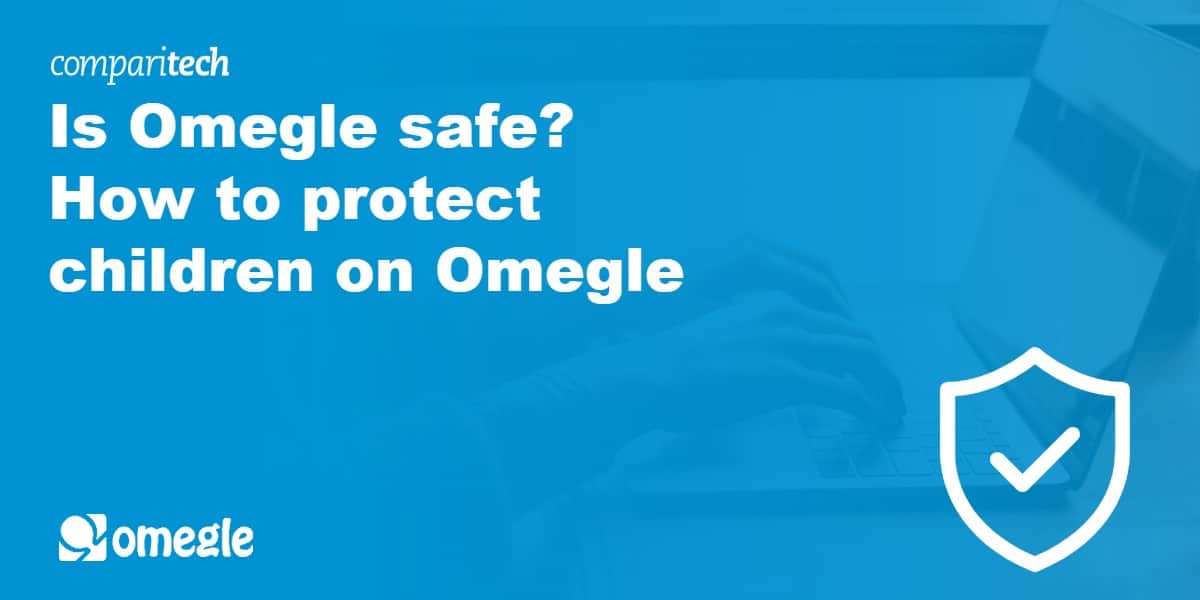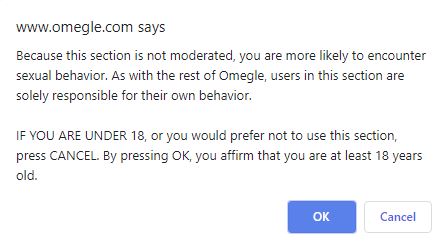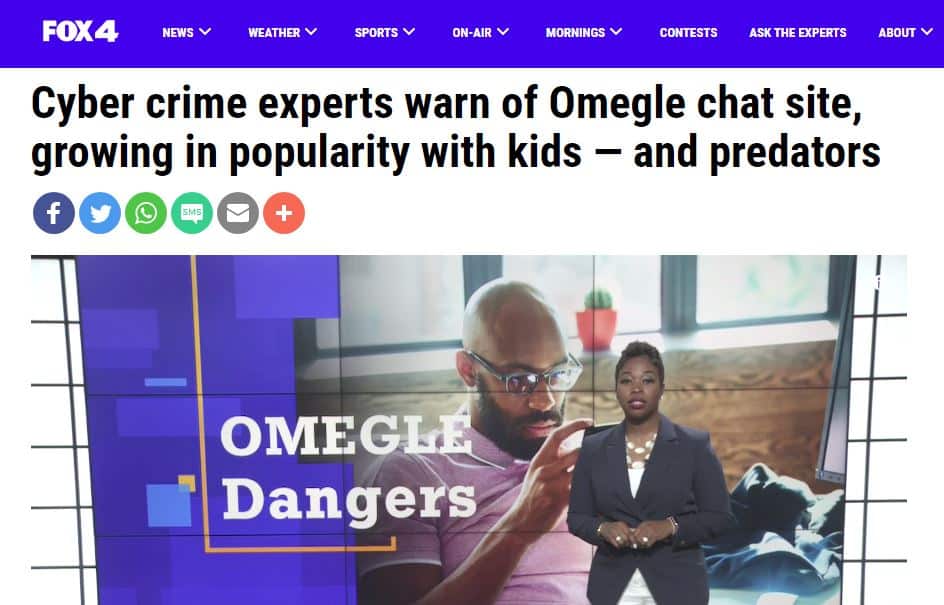
Update: Omegle, the anonymous video chat site has shut down after 14 years after ongoing legal disputes. You can read the founder’s statement here.
Omegle is marketed as an anonymous text and video messaging app that connects users with strangers. This can seem enticing to adults and kids alike, but it can pose many risks to minors. On the one hand, Omegle has morphed into somewhat of a dating app with adult content. While this may seem harmless for over-18s, there are some privacy concerns that may make it unsafe for all users. In addition, a much seedier side to Omegle exposes minors to obscene content or predators.
There is increased concern around Omegle and other online apps during the pandemic. Most children are spending more time online due to various lockdowns and a shift to remote schooling. At the same time, many are craving social interaction. Combined, these factors make apps like Omegle and the concept of talking to strangers both attractive and accessible.
In case you don’t get to read the full article, here’s a quick takeaway: In our opinion Omegle is not safe for children. It appears that much of the content on Omegle is inappropriate for children and there are very few, if any, safeguards protecting minors. Most concerningly, the site is known to be frequented by child predators, and the website itself states: “Predators have been known to use Omegle, so please be careful.”
Many parents who discover how Omegle works (and the people and content kids might encounter) choose to block or ban their children from using it. Indeed, many children make the choice to avoid the app after landing in uncomfortable or even traumatic situations.
In this article, we reveal what you need to know about Omegle, including how the app works and what makes it unsafe for children. We also discuss several steps to follow to protect kids on Omegle.
How does Omegle work?
Omegle offers a means of communication between total strangers. It is mainly limited to two-way conversations (unless users are sharing a device). The platform is available via a desktop or mobile web browser (Omegle Online) or through an Android app. The app is not available on the Google Play Store so anyone wishing to use it will need to download the Android APK file. There are iOS instructions but these simply show how to add the Omegle Online site to the homescreen.
If you conduct an online search for Omegle, you will find two main websites. One houses documentation instructing how to use the platform, while the other is the actual online chat platform.

Near the chat options, in small font, Omegle states:
By using Omegle, you accept the terms at the bottom. You must be 18+ or 13+ with parental permission.
However, there aren’t any mechanisms to stop access by minors. At no point do you need to sign up for an account to use Omegle.
We’ll discuss this more below, but it should be noted that no matter which way or by which age group the app is accessed, according to reviews, there is a strong potential the user will be exposed to adult (and possibly criminal) content, including sexually explicit images or videos, violence, or child pornography.
Omegle has several options for initiating a chat, although these aren’t very clearly laid out on either website. In each case, you’re connected with a stranger. It’s unclear how the match selections are made (although there is an option to enter an interest).
Adult
The 18+ area is highlighted with the warning “Video is monitored. Keep it clean!” and has two options: Adult and Unmoderated Section. While the “adult” label confuses things, the 18+ label presumably means that both of these sections are intended for adults only.
Clicking Adult prompts a warning that you’re going to a site that contains sexual material.
By clicking OK, the user confirms they are 18 years old, but there is nothing to stop a child from doing this. Once the user hits OK, they will arrive at a video chat section of the site with two webcam displays (theirs and the stranger’s). The cams will autoplay and there’s a strong possibility the stranger will be showing live or pre-recorded adult (usually pornographic) content.
Unmoderated Section
Clicking this option prompts a different popup which states that you’re more likely to encounter sexual content here as it’s unmoderated.
Clicking through will take users to another dual-webcam area where they have two options—Sex and Gay—which appear to both lead to sharing sexually explicit live content.
Text
Below the adult section is an optional field for adding an interest. Next to that are the Text and Video options which are open to anyone over the age of 13 (with a parent’s permission for under 18-year-olds). The text option leads to a regular message interface where a stranger will start chatting.
Bear in mind users know nothing about each other, not even a user name or image. There is nothing to stop a child predator coming up with a false persona to befriend your child. While this can be said of many other chat apps, the nature of Omegle (connecting users with strangers under a cloak of anonymity) makes it particularly attractive for predators.
The chat is purported to be anonymous, although either user can choose to save and receive a sharable link to the chat. The saved transcript will include both users’ IP addresses, ID cookies, and other information not disclosed by Omegle. Of course, the anonymity may also be lifted if a user mentions any personally identifiable information.
Spy (question) mode
This option lets a user ask a question for two strangers to discuss while the user observes (although the person posing the question can’t participate in the discussion).
Video
Similar to the 18+ sections discussed above, this option takes users to a dual-webcam screen. While Omegle claims this section is monitored, based on user reviews, it sounds very possible that children can easily encounter adult content here too. It’s also easy for a predator to spark up a seemingly innocent conversation here. They could even cover their webcam to conceal their physical appearance.
College student chat
This option enables users to chat with fellow college students. This is perhaps one of the safer areas of Omegle because users have to enter and verify a college email address (for example, ending in .edu) before using this function. However, this feature is only useful for college kids, not for your younger teens. Omegle states that it “won’t spam you, sell your address, or save it.” Bear in mind, though, that Omegle will share the name of a user’s college with their chat partner and vice versa.
Is Omegle safe? What are the dangers?
Here are the several major concerns associated with kids using Omegle:
- Exposure to explicit content
- Grooming by predators
- Exposure of personal information
- Hacking of private messages and videos
Let’s look at these in more detail:
1. Exposure to explicit and disturbing content
One of the most common concerns from both parents and children is the seemingly unavoidable exposure to explicit content. According to reviewers, most of this pertains to the video chat features in which strangers appear on screen nude and/or carrying out sexual acts. In the modern digital age, it’s considered inevitable that children will be exposed to pornography at a relatively young age, the average being aged 11. However, that doesn’t make the experience of unexpectedly seeing a stranger perform live sexual acts less disturbing for some young brains.
When using any platform, it’s important for both parents and children to know what to expect. One of the issues some have reported with Omegle is that explicit content is unavoidable and any user might be exposed, regardless of what they’re looking for. And as one 15-year old reviewer writes:
There are some things that can’t be unseen, and you’ll see a lot of those things on the video chat for omegle.
In some cases, reviewers of the app have even reported being exposed to child pornography, violence, suicide, and bestiality.
Omegle does claim that some video sections of the site are monitored, but the effectiveness of this is questioned by both reviewers and law enforcement. Speaking to Fox4 about Omegle, an undercover detective (unnamed due to his line of work) for the Western Missouri Cyber Crimes Task Force commented: “They say ‘Hey, we’re watching this,’ but how can they truly watch that many?”
Omegle does warn users about the content of its site, with one notice stating: “Understand that human behavior is fundamentally uncontrollable, that the people you encounter on Omegle may not behave appropriately, and that they are solely responsible for their own behavior.”
The extent of this is revealed by many reviewers, with one parent warning:
This is anonymous video chat where you just click and go. Use your imagination to imagine how awful this is and then multiply that by 10.
Another issue is that although there is a rule that 13 to 18-year-olds must have permission from parents to use the app, there are no controls in place to ensure this rule is being followed. Other apps that allow younger teens to set up an account at least ask for a date of birth. Others, such as Messenger Kids and JusTalk Kids, require verification from a parent before setting up an account and provide controls such as the ability to monitor contacts.
2. Grooming and extortion by predators
It’s no secret that there are many predators lurking online looking to exploit minors. And Omegle is one place where predators have been known to hang out, with police forces in various regions warning parents as such.
Predators can use Omegle to exploit minors in various ways. According to reports, some predators will “groom” children by befriending them, possibly posing as someone else such as a child of a similar age, before trying to exploit them. After gaining their trust, they might suggest taking their relationship to a different platform, request explicit messages, images, or videos, or suggest that they meet in person.
Other predators on Omegle try to scare children into succumbing to their demands. One common tactic for eliciting child pornography is sextortion, which is extortion that involves material of a sexual nature. This strategy may be used even if the victim hasn’t provided any indecent content. For example, according to one 15-year old Omegle reviewer:
“Today I was skipping through, usually I have a cam cover on, but today I didn’t. There was a message that they took a screenshot of my face and if I didn’t show my breasts, then they would make fake porn photos of my face on another body and post it on all platforms. This made me so scared.”
3. Exposure of personal information
One area where minors often lack judgment is in exposing personal information. Although one of the allures of Omegle is the anonymity factor, it can be surprising how quickly children will divulge information such as their name, age, birth date, where they live and go to school, and other seemingly mundane details such as interests and hobbies. All of this can be dangerous in the wrong hands, such as those of hackers or child predators.
The Omegle text chat remains mostly anonymous unless a user discloses any personal details. As its website states:
To help you stay safe, chats are anonymous unless you tell someone who you are (not suggested!), and you can stop a chat at any time.
But it’s also worth bearing in mind that either user can choose to save the chat in the form of a sharable link:
“When you save an Omegle log, the chat’s text is sent from the user’s computer to Omegle’s server, where it is converted to an image, lovingly given a one-of-a-kind arboreal background, and saved indefinitely under a unique, randomly-assigned ID. The IP addresses, ID cookies, and similar information related to the parties in the chat will be stored alongside the chatlog.”
This means that unless a user employs a VPN, their real IP address could be exposed when using the text chat option.
When using the video chat feature, either user could easily take screenshots or a recording of the video. What’s more, the connection is forged directly between the two users’ computers, so their respective IP addresses need to be shared with each other. While the IP addresses won’t pop up in the Omegle interface, it wouldn’t take much for a tech-savvy individual to find that of their chat partner. This information can be used to determine a user’s rough location and in some cases, their identity.
Some users have reported receiving threats from chat partners who tell them they have discovered their IP address and location.
4. Hacking of private messages and videos
According to its privacy policy, the main types of information Omegle collects and stores are:
- Metadata related to each chat including a timestamp and participants’ IP addresses and ID cookies.
- Full text logs of chats that users have chosen to save (as described in the last section).
- Images captured from Omegle video chats used for moderation purposes.
There have been reports of hackers being able to obtain chat records from Omegle servers. If there is any personally identifiable information such as a name, social handle, or address, hackers could use this information for nefarious purposes, including fraud, phishing attacks, cyberstalking, doxing, or even offline stalking. Any sensitive messages, images, or videos could be used to harass or extort the victim.
How to protect children on Omegle
Unfortunately, there is no real safe way for children to use Omegle. Granted, some mature, savvy kids can choose to skip over content they don’t want to see, but this doesn’t stop them from being exposed to potentially traumatic content in the first place.
In addition, even though users can skip content, the app has implemented bot checks and sometimes even bans for users who skip too fast. This makes it more difficult for your child to avoid content that may make them feel uncomfortable.
As such, the only real way for children to stay safe is to avoid the Omegle platform altogether. That said, if your child is particularly curious, here are some guidelines you can follow:
Steer them towards an alternative app
Some of the main allures of Omegle are the anonymity factor and the ability to connect with completely random strangers. Unfortunately, similar apps that promote talking to strangers will present similar issues to those described above. While some apps may be a bit better at monitoring content, ultimately, anonymously connecting with strangers can be dangerous for minors.
A better idea would be to steer your teens toward platforms that enable them to connect more safely with like-minded individuals such as through more reputable social media groups or online forums. That’s not to say these are entirely safe and they come with their own sets of issues, but removing the anonymity factor can lower the risks somewhat.
Consider accessing the app by yourself first
You likely don’t want to be exposed to a lot of the content on Omegle either. But if you’re going to let your child use it (or have discovered they’re already using it), it can be a good idea to see firsthand what you’re dealing with. You don’t actually need to send messages on the app, but you could initiate a chat to see the types of strangers you’re connected with.
Use and talk about the app with your child
If, in the unlikely case, you are okay with your child using this app, then it’s advisable to use it with them. This way, at least you can help them navigate to actual conversations versus the seedy areas of the app. And if they do come across anything uncomfortable, you can discuss with them what they have seen.
Are they already using the app? Or do you have no control of whether or not they access Omegle? The best thing you can do is keep the door open for discussions about what they are talking about or viewing on the platform.
Chances are your child is curious and just wants to access the platform to see what all the fuss is about. But even a short time on the app could expose them to potentially traumatic content. Depending on the child, they may be able to shrug it off or they might feel extremely uncomfortable and regret having seen or read certain content. Whatever their reaction, it’s important to give them a safe place to talk about any concerns.
Brush up on data protection
While you may have had these conversations with your child hundreds of times, it’s crucial to reiterate the importance of keeping personal data private. Remind your child that they should never share personal details such as their name, age, or where they live or attend school. Educate them on the fact that even though the chats are purportedly anonymous, there are still ways a stranger could find out information.
It’s also worth repeating conversations about the permanency of online data. Anything that happens in a video or web chat could be made permanent using a simple screenshot or screen recorder app.
Use the filter options
Omegle does give users the option to filter matches by interests. Although this is far from reliable, it could help filter out some of the inappropriate content. For example, listing “sex” as an interest and entering a video chat is very likely to see a user matched with strangers who are showing genitalia or performing sexual acts, or asking their chat partner to do the same.
Listing other interests such as “soccer” or “gaming” may give users a better chance at being matched with a like-minded individual for genuine conversation. That said, this could be even more dangerous for children as predators may use innocent-sounding interests to lure in youngsters.
Block Omegle using parental control apps
In the terms of use, Omegle does point parents in the direction of third-party tools that can help control kids access to Omegle.
“Parental control protections (such as computer hardware, software, or filtering services) are commercially available that may assist you in limiting access to material that is harmful to minors. If you are interested in learning more about these protections, information is available at http://kids.getnetwise.org/tools/ as well as a number of other Internet sites that provide information on this form of protection.”

Indeed, there are a ton of great parental control apps available. That said, while these may work for younger children, many teens are capable of circumventing these types of controls, so having discussions around the app should still be considered an important step.
Use a VPN
At the very least, if your teen is using Omegle, they should also use a VPN. This will replace their real IP address with a VPN IP address from the location of the user’s choice. This way, if their chat partner does discover their IP address, it won’t be their real one and they won’t be able to derive any information from it.
When choosing a VPN, it’s important to find one that offers leak protection to ensure no personal information escapes the connection.
We recommend NordVPN, which also has a kill switch to block the internet connection should the VPN connection fail.
See also: Best VPNs for Omegle







Hi! Thanks for the help!